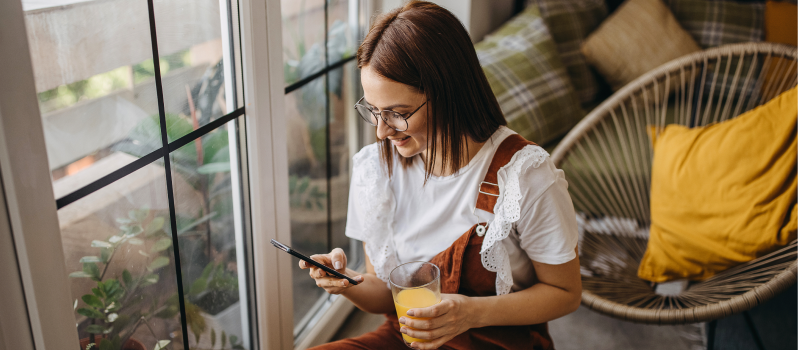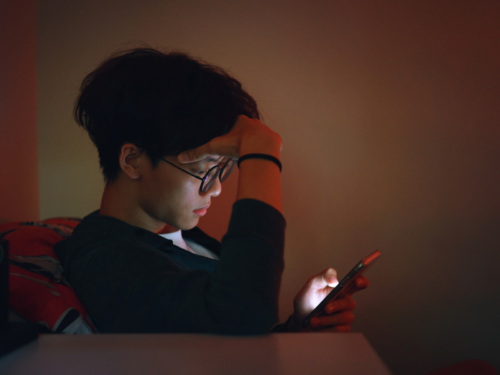
Table of Contents
New Research Finds TikTok Helps Create Unique Mental Health Communities for Teens

Written By: Sarah Fielding

Clinically Reviewed By: Dr. Don Gasparini
March 15, 2023
6 min.
An analysis of TikTok videos shows how young people are creating communities of information to subvert barriers to accessible care
Learn more about our Clinical Review Process
Table of Contents
When it comes to mental health, it’s incredibly beneficial to have a supportive and understanding community. The people you interact with can increase your awareness of mental health conditions and treatment options, from therapy to medication. They might also suggest healthy coping mechanisms to help you manage symptoms.
This network may include your friends, family, or even your chosen family.
You may also look elsewhere for support, including social media. Whether it’s because you don’t yet feel comfortable sharing your emotions with a loved one or because they might not have the knowledge and resources you’re looking for, social media is an increasingly popular platform for teens and young adults to build communities around mental health support. One platform that’s grown particularly popular for community-building–especially for teens–is TikTok.
According to new research, now more than ever, young people are using TikTok to foster spaces to share mental health information. What’s more, they’re using the platform to simultaneously subvert traditional barriers to mental healthcare.
The latest research on TikTok and mental health
A recent analysis from Computers and Composition: An International Journal examined how conversations and communities develop on TikTok around mental health. Chandler Mordecai, the paper’s author, investigated the top 10 TikTok videos that used #anxiety to determine how users interacted with and created communities through these videos.
On TikTok, “#anxiety” has 24.7 billion views. The ten videos highlighted in this latest research focused on either personal testimony or videos of calming practices.
Mordecai looked at how TikTok’s content distribution factors into how young people connect across the platform. Unlike Facebook and Instagram, TikTok depends less on who you’re following and more on what content aligns with your interests. This distinction can allow users to find a wider-ranging community of people with similar conditions and questions. He also examined affordance, “the qualities of social media platforms that encourage participation and potential user action.”
The analysis showed how users create, comment on, and share videos in ways that connect them to other users in the mental health space. Beyond likes and comments, users can connect more intimately through interactive features such as duet and stitch. In one example, a content creator uses the duet feature to encourage people to eat together.
“If you ever had a hard time sitting yourself down to eat lets eat together,” the text states. They then provide commentary that helps ease a second creator into the meal. This is a unique and incredibly helpful way of creating community and togetherness that would be difficult to achieve outside of TikTok.
Uplifting comments on TikTok also play a significant and positive role in building these connections. Mordecai found users commenting positive affirmations on creator’s videos, such as, “you got this, I believe in you so much.” Creators would then like comments and respond, creating a bond.
Mordecai suggests this movement can broaden the conversation around anxiety, providing helpful information and support while breaking down stigmas. Healthy coping mechanisms and support were also made more accessible.
Join the Charlie Health Library
Get mental health updates, research, insights, and resources directly to your inbox.
You can unsubscribe anytime.
The dangers of misinformation on TikTok
It is commendable that TikTok provides an avenue for the development of supportive mental health communities. At the same time, it’s critical to remember that both TikTok and other social media platforms can breed misinformation. This may come in the form of a misdiagnosis based on a video or unhealthy coping mechanisms.
The Computers and Composition analysis also notes that young people of color may not be as inclined to discuss their mental health through social media. This uncertainty can stem from historical trauma within communities of color, in addition to continuous racism across the digital space.
One option is to use TikTok as a jumping-off point while maintaining a critical eye for verifiable and authoritative information. Make sure to follow reputable organizations’ websites, such as governments and hospitals, to fact-check the information you hear.
With that in mind, read on to learn more about anxiety disorders and how they manifest.

What is an anxiety disorder?
A person living with an anxiety disorder might experience high levels of anxiety or fear in moderately stressful situations. Anxiety disorder symptoms can include muscle aches, fatigue, difficulty concentrating, and feeling overwhelmed. Anxiety disorders are common and often manageable through care and medication. According to the Anxiety and Depression Association of America (ADAA), about 40 million adults experience anxiety disorders yearly, making them the most common mental health issue in the United States.
Different conditions fall under the umbrella of anxiety disorder. Here are some of the most common ones to know.
Generalized anxiety disorder
The ADAA reports that about 6.8 million people experience general anxiety disorder (GAD) annually. A person is diagnosed with GAD if they worry more days than not over six months while exhibiting three or more of GAD’s symptoms. GAD’s symptoms include nervousness, a sense of impending danger, fatigue, trouble sleeping, gastrointestinal issues, and hyperventilating.
Obsessive-compulsive disorder
While it’s societally associated with needing things to be extremely clean, obsessive-compulsive disorder (OCD) is a much more complex mental health condition than “germaphobia.” OCD symptoms can include cleaning alongside experiencing repetitive thoughts or doing the same thing repeatedly. It typically manifests in adolescence, with an estimated one in 200 young people having OCD.
Panic disorder
A panic attack on its own isn’t evidence of a panic disorder. However, experiencing regular panic attacks — a feeling akin to a heart attack — alongside worrying (or even obsessing) about when you’ll have your next panic attack and being scared to return to locations of past panic attacks can be. An estimated 2.7% of adults and 2.3% of adolescents live with panic disorder, reports the National Institute of Mental Health.
Phobias
When you think of phobias, you probably think of ones like claustrophobia (small spaces) or acrophobia (spiders). But, with almost 20 percent of adolescents alone having a phobia, there’s one for just about anything. Phobias can include everything from chaetophobia (hair) to nomophobia (being without a phone).
Post-traumatic stress disorder
A diagnosis of post-traumatic stress disorder (PTSD) was initially associated with combat veterans but has broadened to the general public. People who experience PTSD lived through or witnessed a traumatic event and have symptoms such as intrusive thoughts, avoidance, distorted thoughts, and irritability. PTSD can also come from fear for a loved one after a harrowing incident. An estimated six percent of people experience PTSD at some point.
Separation anxiety disorder
A person of any age can experience separation anxiety disorder. This condition is characterized by fear or anxiety about separating from a close associate and worry about losing them, reports the American Psychiatric Association (APA). It must last over four weeks for children and over six months for adults to classify as SAD. Approximately 0.9-1.9 percent of adults live with separation anxiety disorder yearly.
Social anxiety disorder
A person living with social anxiety disorder — formerly known as social phobia — will experience extreme fear or anxiety in particular or all social situations. These places might be anywhere from parties or public restrooms. Symptoms of social anxiety disorder can include blanking out, dizziness, using substances before going to a public setting to calm nerves, and fear of being judged. The APA reports that about seven percent of adults live with social anxiety disorder yearly.
Do you need more support with
your mental health?
Charlie Health can help.
Staying safe on social media
You can build digital communities while navigating anxiety if you're safe and careful. When there is the opportunity to find people you bond with and feel safely connected to, embrace it. Mental health education and care can often feel inaccessible, and these communities might help you break down the barrier and gain a greater understanding of others and, importantly, yourself.
At Charlie Health, we are committed to accessible mental healthcare for all. Teens and young adults are in the midst of an unprecedented mental health crisis, and we are fighting every day to break down barriers, optimize care, and save lives. If you or a loved one are struggling with mental health and are in need of more support than weekly therapy, reach out today.





